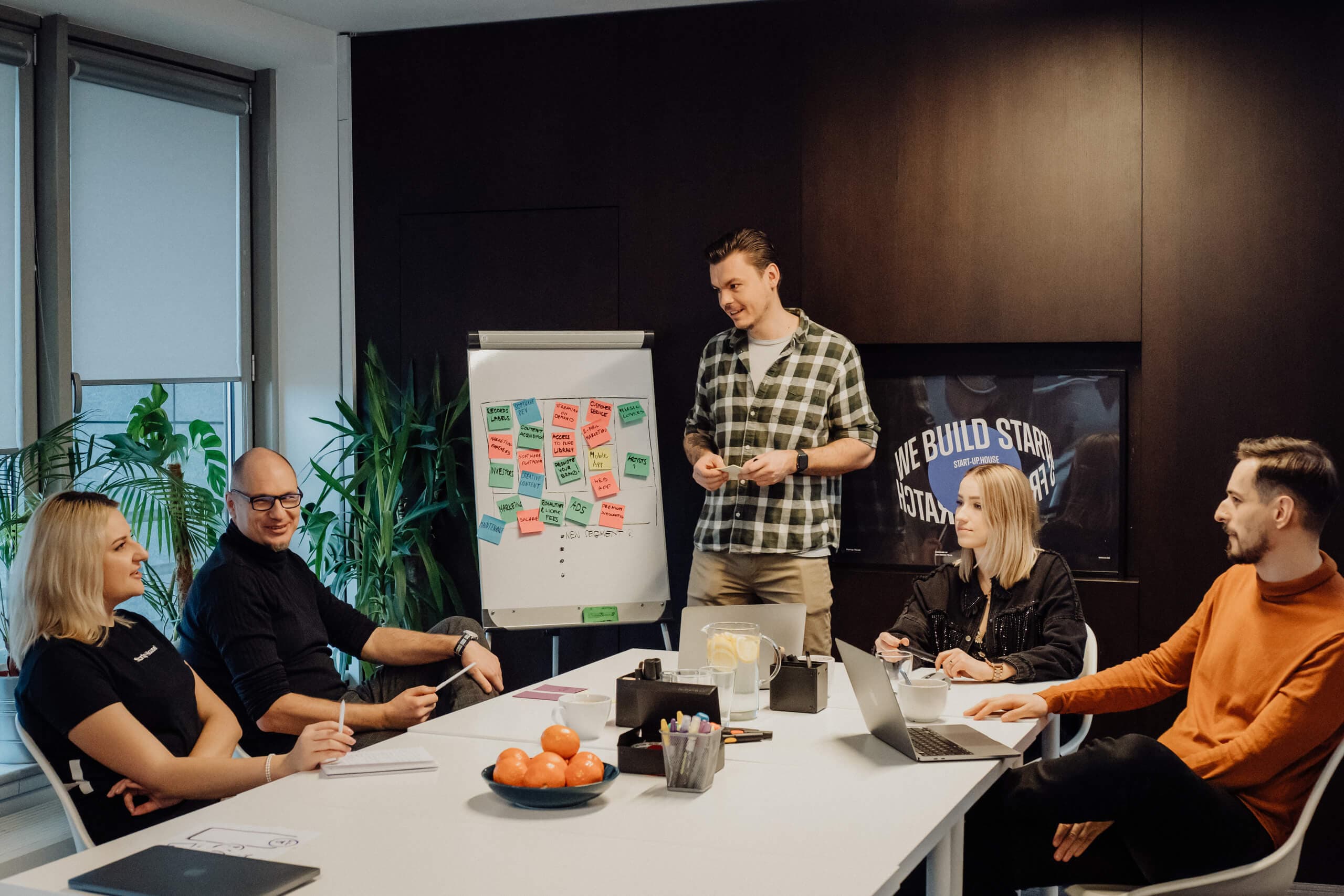Navigating the Stages: Understanding the Product Life Cycle in Software Development
Marek Pałys
Apr 09, 2024・11 min read
Table of Content
Introduction to the Product Life Cycle
What is the Product Life Cycle?
Importance in Software Development
Stages of the Product Life Cycle
Development and Introduction
Growth and Expansion
Maturity and Saturation
Challenges During Maturity
Strategies for Sustaining Growth
Decline and Renewal
Recognising the Decline Phase
Options for Renewal or Exit
Practical Applications and Case Studies
Successful Product Life Cycle Management
Lessons from Industry Leaders
FAQs
Understanding the Product Life Cycle in Software Development is crucial for anyone involved in creating or managing software. This cycle outlines the stages a software product goes through, from its initial concept to its eventual decline. By grasping these stages, developers, managers, and stakeholders can make informed decisions, ensuring the software remains relevant and competitive in the market. In this guide, we will delve into each phase of the product life cycle, providing practical insights and examples to help you navigate this essential aspect of the software development process with confidence and clarity.
Introduction to the Product Life Cycle
What is the Product Life Cycle?
The Product Life Cycle is a framework that describes the stages a product undergoes systems development lifecycle, from its inception to its discontinuation. In software development, this cycle typically includes the phases of introduction, growth, maturity, and decline. Each stage presents unique challenges and opportunities. During the introduction phase, the focus is on building awareness and attracting early adopters. In the growth stage, the aim is to increase market share and improve features. Maturity involves optimising the product to maintain its position, while the decline phase often requires decisions about updates or discontinuation. Understanding the Product Life Cycle in Software Development enables teams to anticipate changes and plan strategic actions accordingly. By recognising where a product is in its life cycle, developers and managers can allocate resources efficiently and adapt their strategies to extend the product's market relevance.
Importance in Software Development
The significance of the Product Life Cycle in software development cannot be overstated. It provides a strategic roadmap that guides developers and managers through the product's evolution, helping them to foresee potential hurdles and opportunities. By understanding the development life cycle into distinct phases, teams can align their efforts to meet user needs and market demands effectively. For instance, during the introduction phase, resources are often directed towards marketing and initial development, while in the growth stage, scaling and feature enhancement become priorities. Additionally, recognising the onset of maturity or decline allows for timely innovation or pivot strategies, preventing loss of market relevance. This understanding also aids in budgeting and resource allocation, ensuring that investments are optimised for the product's current stage. Overall, appreciating the Product Life Cycle equips software teams with the foresight needed to sustain a product’s success and longevity in a competitive landscape.
Stages of the Product Life Cycle
Development and Introduction
The development and introduction stages set the foundation for a software product’s journey. Initially, the focus is on ideation and creating a prototype. This phase involves identifying user needs, market research, and defining the product's core features. During software development lifecycle, teams build the software, conduct rigorous testing, and prepare for launch. It's a period of significant investment, both in terms of time and resources, as the goal is to produce a viable product that can attract early adopters. Once the product is ready, it enters the introduction phase. Here, marketing strategies are crucial to generate awareness and interest among potential users. Feedback gathered during this stage is invaluable, as it can guide improvements and adjustments. Successfully navigating these phases is critical, as they lay the groundwork for future growth and adoption, ensuring the software is well-positioned to meet user expectations and market demands.
Growth and Expansion
During the growth and expansion stage, the software product begins to gain traction and market share. This phase is characterised by increasing user adoption and the need for scalability. Development efforts focus on refining features, improving user experience, and addressing any issues identified during the introduction phase. Marketing strategies shift towards broader outreach to capture a larger audience and emphasise the product's unique value propositions. Additionally, customer feedback becomes paramount, guiding enhancements and new feature development. It's also a period where competitive pressures intensify, necessitating continuous innovation to stay ahead. Revenue typically starts to increase, allowing for reinvestment in marketing, research, and product development. Effective management during this stage ensures that the product can handle the growing user base and maintain a high level of performance and reliability. By capitalising on the momentum gained, teams can solidify the product’s position in the market and lay the groundwork for long-term success.
Maturity and Saturation
Challenges During Maturity
The maturity stage brings stability but also a unique set of challenges. As the software product reaches its peak in market saturation, growth rates slow down. The focus shifts from acquisition to retention, necessitating strategies to keep the existing user base engaged. Competition is often fiercer, with alternative products vying for market share. Innovation becomes critical to differentiate the product and add value for users. Additionally, maintaining the software's performance and reliability is paramount. Any downtime or significant bugs can lead to user attrition. Cost management also becomes important; with slower revenue growth, optimising operational efficiency is crucial. The risk of complacency is another challenge. Teams must remain vigilant and proactive, seeking opportunities for incremental improvements or even exploring new markets or use cases. Successfully navigating these challenges during testing phase of maturity ensures the product continues to deliver value and maintains its market position amidst increasing competition.
Strategies for Sustaining Growth
To sustain growth during the maturity stage, software teams must implement strategic initiatives focused on both retention and innovation. Enhancing customer engagement through personalised experiences and robust support systems can increase user loyalty. Regular updates, informed by user feedback, help keep the software relevant and valuable. Diversifying the software testing product offering by introducing complementary features or services can also attract new users and expand the existing user base. Exploring partnerships with other businesses can open new distribution channels and broaden the product's reach. Additionally, penetrating new markets, whether geographic or demographic, offers opportunities for fresh growth. Effective use of data analytics is crucial to understand user behaviour and identify trends that can inform strategic decisions. By implementing these strategies, teams can maintain momentum and extend the product's lifecycle, even in a saturated market. This proactive approach ensures that the software remains competitive and continues to deliver value to its users.
Decline and Renewal
Recognising the Decline Phase
Recognising the decline phase of a software product development lifecycle is crucial for making informed strategic decisions. Indicators of this stage include a noticeable drop in sales or user engagement, increased competition, and technological obsolescence. As user needs evolve, the product may no longer meet market demands, leading to a gradual loss of relevance. Monitoring key performance metrics is essential to identify early signs of decline. When such indicators emerge, it's vital for teams to assess the product’s viability and explore options for renewal or discontinuation. This might involve pivoting to a different market segment, revamping the product with new features, or integrating advanced technologies. It's also an opportunity to evaluate the product portfolio and allocate resources to more promising ventures. By recognising the decline phase early, software teams can make proactive adjustments, potentially revitalising the product and extending its lifecycle, or strategically phasing it out in favour of new opportunities.
Options for Renewal or Exit
When faced with the decline phase, software teams have several options for renewal or exit. Renewal strategies might involve refreshing the product through significant updates or redesigns to better align with current market needs. Incorporating emerging technologies or features can rekindle interest and attract new users. Alternatively, repositioning the product for a different audience or niche market can breathe new life into its relevance. If renewal isn’t viable, an exit strategy may be more appropriate. This could involve phasing out the product while ensuring a smooth transition for existing users, perhaps by providing support for a limited time or offering migration options to other products. Selling the product or its intellectual property to another company is another exit path. Each option requires careful consideration of market conditions, user impact, and long-term business goals of development team. By evaluating these options thoughtfully, teams can make strategic decisions that align with their overall objectives and optimise resource allocation.
Practical Applications and Case Studies
Successful Product Life Cycle Management
Successful management of the Product Life Cycle in software development requires strategic foresight and adaptability. Companies that excel in this area often employ a proactive approach, anticipating changes and responding with agility. For instance, they leverage data analytics to track user engagement and market trends, allowing them to make informed decisions at each stage of the software development life cycle. Regular updates and feature enhancements are prioritised to maintain relevance and user satisfaction. Additionally, effective communication with users ensures that feedback is integrated into the development process, fostering loyalty and trust. Some companies also diversify their product offerings, creating complementary tools or services that enhance the core product’s value. By understanding and addressing the unique challenges of each life cycle stage, these organisations are able to optimise their product’s longevity and profitability. Successful case studies demonstrate that a well-executed life cycle management strategy not only extends a product's market presence but also strengthens the company's competitive position.
Lessons from Industry Leaders
Industry leaders in software development offer valuable insights into effective Product Life Cycle management. These companies often prioritise innovation and user-centric approaches. For example, tech giants continuously invest in research and development to stay ahead of technological advancements and market shifts. They also embrace agile methodologies, an agile model allowing for flexibility and rapid adaptation to changes. Another key lesson is the importance of building strong relationships with users. This involves not only gathering feedback but also engaging with users through community forums and social media. Moreover, successful leaders are adept at recognising when to pivot or introduce new products, ensuring their offerings remain competitive. They often diversify their product portfolios, reducing reliance on a single product and spreading risk. By studying these strategies, other companies can learn how to effectively navigate the Product Life Cycle, maintain market relevance, and achieve sustainable growth. These lessons underscore the importance of strategic planning and a proactive mindset in software development.
FAQs
What is the product life cycle in software development?
It refers to the stages a software product goes through, including development, growth, maturity, and decline.
Why is understanding the product life cycle important?
It helps teams anticipate challenges, allocate resources effectively, and ensure the product remains relevant in a competitive market.
What are the stages of the product life cycle in software?
The stages include introduction (or development), growth, maturity, and decline, each requiring specific strategies.
How does the introduction stage work in software development?
This stage focuses on building and launching the product, with an emphasis on creating awareness and attracting early adopters.
What happens during the growth stage?
The product gains users, scales features, and focuses on improving performance and expanding the market presence.
What challenges are faced during the maturity stage?
Growth slows, competition intensifies, and the focus shifts to retaining users and adding incremental improvements.
How do companies sustain growth during maturity?
Strategies include enhancing features, improving user experience, exploring new markets, and maintaining strong customer engagement.
What is the decline stage in software development?
The decline stage occurs when user interest wanes, and the product becomes obsolete or less competitive, requiring renewal or exit strategies.
How do companies recognise the decline phase?
Indicators include decreasing user engagement, reduced sales, and market shifts that diminish the product's relevance.
What are the options for a product in the decline phase?
Teams can either renew the product with updates or new features, pivot to a new market, or phase out the product entirely.
How can software products be renewed during the decline stage?
Renewal involves significant updates, redesigns, or repositioning to align with current market demands and technology trends.
What is the importance of user feedback in managing the product life cycle?
User feedback helps identify issues, guides feature development, and ensures the product remains user-centric at every stage.
How can data analytics support life cycle management?
Analytics provide insights into user behavior, market trends, and product performance, helping teams make informed decisions.
What role does innovation play in the product life cycle?
Continuous innovation keeps the product competitive and helps extend its life cycle by meeting evolving user needs.
How do agile methodologies benefit the product life cycle?
Agile allows teams to quickly adapt to changes, iterate on feedback, and release updates efficiently to stay aligned with market demands.
Why is scaling important during the growth stage?
Scaling ensures that the product can handle an increasing user base and growing demand without compromising performance.
What are common challenges during the growth stage?
Scaling infrastructure, managing user feedback, and maintaining high performance while expanding features are typical challenges.
How can companies manage competition during the maturity stage?
By focusing on differentiation, improving user experience, and offering new value propositions to retain and attract users.
What are some examples of successful life cycle management?
Companies like Google and Facebook regularly introduce updates and innovations to extend their products' life cycles.
How do industry leaders handle the decline phase?
Leading companies often either reinvigorate their products with new features or gracefully phase them out while launching new initiatives.
Digital Transformation Strategy for Siemens Finance
Cloud-based platform for Siemens Financial Services in Poland


You may also like...

How a Full-Service Software House Accelerates Product Development
A full-service software house gives you everything you need to launch fast — design, development, QA, DevOps — all under one roof. Here’s how it accelerates your product success.
Alexander Stasiak
Jul 03, 2025・7 min read

The Innovation Product Life Cycle: Phases and Strategic Insights
Mastering the innovation product life cycle—from ideation to renewal—gives businesses a competitive edge in a fast-evolving market. This guide unpacks each phase and offers strategic insights to help you plan, adapt, and thrive.
Alexander Stasiak
Jun 24, 2025・10 min read

Mastering Declarative Programming: Essential Practices for Every Developer
Discover declarative programming essentials. This guide covers principles, tools, and best practices to simplify coding, enhance readability, and improve scalability.
Marek Pałys
Apr 16, 2024・11 min read
Let’s build your next digital product — faster, safer, smarter.
Book a free consultationWork with a team trusted by top-tier companies.








